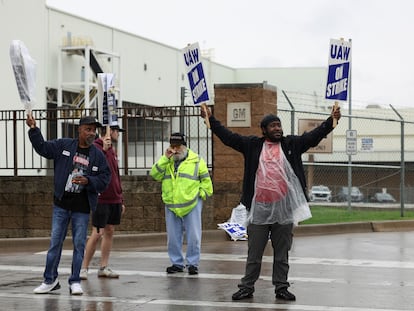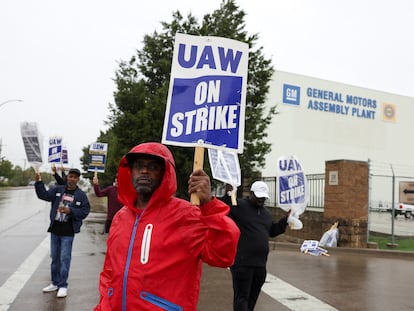US autoworkers notch up a victory with big wage gains after historic strike
The UAW union will now seek to include workers from non-unionized factories, such as Tesla and foreign manufacturers like Toyota, Hyundai and Volkswagen


Autoworkers have won the historic strike in the United States, the first one called simultaneously against Detroit’s Big Three. After just over six weeks of conflict, Ford, General Motors and Stellantis (which acquired Chrysler) have reached tentative agreements with the United Auto Workers (UAW) union to end the conflict. The parties have agreed on collective agreements lasting four and a half years that represent a triumph for the workers, with minimum wage increases of 25% and other labor achievements that allow them to cling to a middle class from which they saw themselves excluded. The success marks a time of rebirth for the unions. The outcome is also a political triumph for the president of the United States, Joe Biden, who joined a picket line in a gesture that went down in history.
UAW President Shawn Fain got the timing, narrative and strategy right. He achieved the support of public opinion in a country not friendly to strikes, he used the record corporate profits and the multimillion-dollar salaries of their executives and hit the companies with a carrot-and-stick strike strategy in which he rewarded or punished companies depending on the evolution of negotiations. As he had done before with Ford and Stellantis, the last move was to paralyze the most important General Motors plant, the only one left to close an agreement. It has been a long, but partial strike that has only affected some of the factories and distribution centers of the auto giants. At its peak, more than 40,000 workers out of the approximately 146,000 union members of the three companies were on strike.
The workers, who have yet to ratify the agreements, are exacting their revenge for the sacrifices they made during the 2007-2008 financial crisis, when the very viability of the companies was in question. At that time they accepted a loss of purchasing power, gave up benefits, accepted wage tiers and opened the door to hiring more temporary workers.
Although there are variations between the different agreements, all of them include a 25% hike in hourly wages until April 2028, and with adjustments for the cost of living, it will mean more than 30%, up to more than $40 per hour for the typical worker. The increases for the lowest paid employees are much higher. The agreements also include improvements in pension plans and restrictions on temporary employment, shorter application periods of the wage tiers, and recognizing the right of workers to strike in protest against factory closures. The salary improvements, the UAW has highlighted, are greater than those accumulated in the last 22 years.
“We have achieved what just a few weeks ago they told us was impossible,” said Fain, celebrating one of the agreements. Despite the achievements, the UAW maintains its combative tone and now wants to try to get workers from non-unionized plants, such as the Tesla factory in Texas, or those of foreign manufacturers such as Volkswagen, Honda or Toyota, to join the UAW. One of the union’s biggest goals after this historic contract victory is “to organize ourselves like we have never done before,” said Fain on Sunday. “When we return to the negotiating table in 2028, it won’t just be with the Big Three. It will be with the Big Five or the Big Six.”
Union success
The strike is a huge personal success for Fain, who narrowly became union president in March in the first UAW election in its 88-year history in which the leader was elected by direct vote of its members. Previously, union officials were elected by delegates in a procedure tainted by cronyism that led to a period of widespread corruption. Fain won with his protest messages, his promises to clean up the union and his attacks on corporate greed. He has been affiliated with the UAW since he began working in 1994 as an electrician at the Chrysler foundry plant in Kokomo, Indiana, his hometown.
Three of Fain’s four grandparents were affiliated with the UAW. One began working at Chrysler in 1937, the year the union emerged with the Sit Down strikes, to which the current leader has made a historic nod by calling the mobilization the Stand Up strikes. Initially, he broke with the tradition of singling out one of the companies as a strike target and then demanding the other two match their concessions. Fain decided to attack all three at the same time, gradually, but in the end he has used the achievements at Ford to close similar agreements with Stellantis and GM. The last one closed on the day Fain turned 55.
Matthew Huber, a professor of geography and environment at Syracuse University, calls the outcome of the strike a huge victory for the United Auto Workers and its workers. “It shows that when workers harness their collective power through strikes, they can force employers to give in to workers’ ambitious demands,” he said. According to Huber, this year is set to become the one with the most strikes in 40 years and “could mark the rebirth of a more combative labor movement in the United States.”
For companies, the agreement increases costs and deteriorates margins in the midst of the transition to electric vehicles, although it does so in a context of strong demand that has allowed companies to raise prices sharply and achieve record sales and profits. Ford and General Motors have withdrawn their earnings forecasts for this year until they evaluate the consequences of the agreement. The new labor cost structure deteriorates their competitiveness against their great national competitor, Tesla, which last year became the first American company in the sector by profits, and against foreign automakers, many of which have factories in the United States, such as Toyota, Honda, Hyundai, Nissan or Volkswagen, which have been gaining market share.
Investors have punished the affected companies on the stock market, especially GM and Ford, which are more dependent on the national market and have suffered price declines of around 20% in the six weeks of the strike.
Biden, who calls himself the most pro-union president in U.S. history, celebrated the agreements. The president campaigned insistently with the unions before the midterm elections to retain the worker vote of three traditionally Democratic states (Pennsylvania, Wisconsin and Michigan) that are part of the Rust Belt, where heavy industry is concentrated. In 2020, he won in all three after attracting the vote of white industrial workers who feel like victims of globalization.
At an event on artificial intelligence held this Monday at the White House, Biden described the agreement as “historic” and said that it rewards the automotive industry workers who sacrificed so much to keep the sector functioning through the crisis. “This historic contract is a testament to the power of unions and collective bargaining to build strong middle-class jobs while helping our most iconic American companies thrive,” he said.
Sign up for our weekly newsletter to get more English-language news coverage from EL PAÍS USA Edition
Tu suscripción se está usando en otro dispositivo
¿Quieres añadir otro usuario a tu suscripción?
Si continúas leyendo en este dispositivo, no se podrá leer en el otro.
FlechaTu suscripción se está usando en otro dispositivo y solo puedes acceder a EL PAÍS desde un dispositivo a la vez.
Si quieres compartir tu cuenta, cambia tu suscripción a la modalidad Premium, así podrás añadir otro usuario. Cada uno accederá con su propia cuenta de email, lo que os permitirá personalizar vuestra experiencia en EL PAÍS.
¿Tienes una suscripción de empresa? Accede aquí para contratar más cuentas.
En el caso de no saber quién está usando tu cuenta, te recomendamos cambiar tu contraseña aquí.
Si decides continuar compartiendo tu cuenta, este mensaje se mostrará en tu dispositivo y en el de la otra persona que está usando tu cuenta de forma indefinida, afectando a tu experiencia de lectura. Puedes consultar aquí los términos y condiciones de la suscripción digital.
More information
Archived In
Últimas noticias
Alain Aspect, Nobel laureate in physics: ‘Einstein was so smart that he would have had to recognize quantum entanglement’
Imelda Castro, the woman who wants to rule the cartel battleground of Sinaloa
The new victims of the Republican war on Obamacare: Millions hit by soaring health insurance premiums
A country divided on migrant rights: Some US states expand protections while others restrict them
Most viewed
- David King, chemist: ‘There are scientists studying how to cool the planet; nobody should stop these experiments from happening’
- Reinhard Genzel, Nobel laureate in physics: ‘One-minute videos will never give you the truth’
- Oona Chaplin: ‘I told James Cameron that I was living in a treehouse and starting a permaculture project with a friend’
- Sinaloa Cartel war is taking its toll on Los Chapitos
- Mexico completes its trade shift with the entry into force of tariffs on China and countries without trade agreements










































